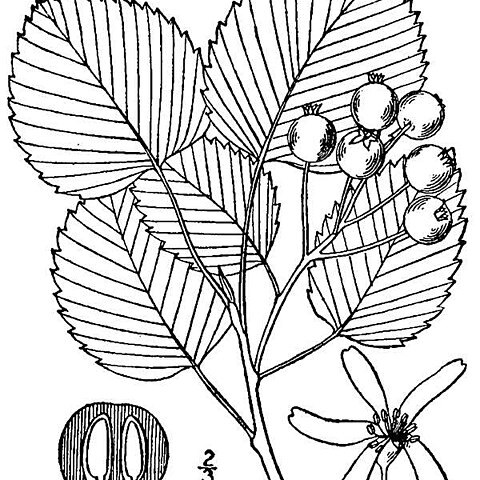Erect or straggling shrub or small tree to 3(–6) m, usually with several clumped stems; lvs at anthesis half-grown and tomentose beneath, eventually glabrous, oblong to subrotund or quadrate, to 7 cm, mostly 1–1.5 times as long as wide, rather coarsely toothed (often only above the middle), with mostly 3–5 teeth per cm of margin, seldom more than 20 per side; lateral veins more than half as many as the teeth, parallel, straight or slightly curved, simple or once (rarely twice) forked, each vein or fork running to a tooth; racemes loose and open, the lower pedicels mostly (1–)1.5–3(–4) cm; sep recurved from near the middle after anthesis; ovary tomentose at the summit; mostly polyploid. Mostly in open woods; Me. and s. Que. to Minn., s. to N.Y., n. N.J., Mich., and Io., and irregularly in the mts. to N.C. and Tenn. May, June. Var. sanguinea, with the range of the species, has pedicels to 3 cm, the pedicels and sep usually retaining their tomentum until after anthesis; the hypanthium is cupulate, 4–7 mm wide, and the pet are mostly 10–18 mm. (A. humilis; A. huronensis) Var. grandiflora (Wiegand) Rehder, restricted to c. N.Y., has the pedicels and hypanthium soon glabrescent, the hypanthium saucer-shaped and 7–9 mm wide, the pedicels 2.5–4 cm, and the pet 15–22 mm. (A. amabilis)
More
A shrub to 3-10 m high. Plants produce suckers and form thickets. The leaves are oval or roundish and 3-7 cm across. They have coarse teeth. There are about 18-20 per side. The flowers occur in drooping clusters. They are 3-8 cm long. Fruit are produced in clusters. The fruit are 11 mm across. They are dark purple and juicy. The stalks are 10-30 mm long.
It is a temperate plant. It grows naturally in open woods, rocky slopes and river banks on neutral to slightly calcareous soils in Eastern N. America from Maine to New Jersey, west to Minnesota and Iowa. It is resistant to frost but sensitive to drought.
More
Margins of woods, open woods, river ledges, shorelines, rocky slopes, crevices of open rock faces and cliffs, noncalcareous to slightly calcareous sites; at elevations to 1,000 metres.
It can be grown from seed, layering or suckers. Unless fresh seed are used, seed can take 18 months to germinate and layers can take 18 months to form roots.


